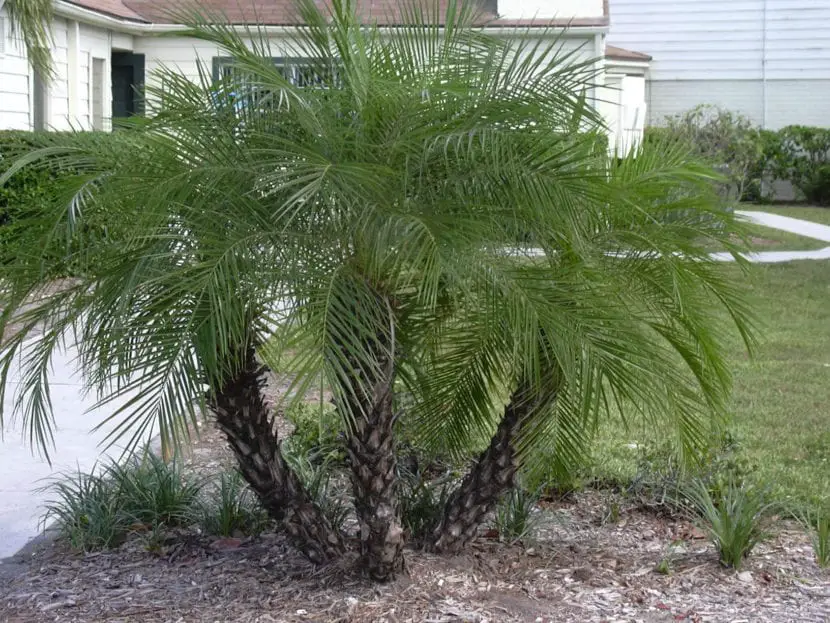
The Phoenix roubleni it is one of the most interesting palm trees. With a height that does not exceed five meters, and as it also has a thin trunk, it can be grown in small gardens and even in large pots.
Its maintenance is very simple, so much so that if you want to start in the world of this type of plants, one of the most recommended is precisely it: the dwarf palm. Here is her file so you can know her and take good care of her.
Origin and characteristics

Our protagonist is a unicaule palm (that is, with a single trunk) endemic to Southeast Asia, specifically in the southwest of China (Yunnan), northern Laos and Vietnam. Its scientific name is Phoenix roublenialthough it is known as dwarf palm, pygmy palm, roebeleni palm or pygmy date palm. It reaches a maximum height of 5 meters, with pinnate leaves up to 140cm long whose pinnae or leaflets are 20cm long.
The flowers, which appear in summer, are grouped in 45cm long inflorescences, and are interfoliar panicles that are protected by a spathe. The fruit is a globose rump 1cm long and dark in color when ripe.
What are their cares?

If you want to have a copy, we recommend that you provide it with the following care:
Location
- Outdoor: I advise putting it in semi-shade, since its leaves burn easily in the sun if they are not used to being directly exposed to the sun.
- Interior: it can be inside the home as long as there is plenty of light in the room where it is to be placed and where it is away from drafts.
Earth
- Flower pot: universal culture substrate mixed with 30% perlite.
- the garden: it does not matter if you are fertile and have good drainage.
Irrigation
The frequency of watering will vary depending on the weather and location. Therefore, and taking into account that it does not tolerate waterlogging, The best we can do is check the humidity of the soil before watering in any of these ways:
- Weigh the pot once it has been watered and again after a few days: as wet soil weighs more than dry soil, this difference in weight serves as a guide to know when to water.
- Insert a thin wooden stick to the bottom: if when you take it out it comes out practically clean, we will water since that will mean that the earth is dry.
- Use a digital moisture meter: when introduced into the ground, it will instantly tell us what degree of humidity is that portion of the substrate that has come into contact with it. Of course, to be really useful it is important to introduce it in other areas, such as closer to the plant and again further away.
Subscriber
As important as the irrigation is the subscriber. And it is that no living being can stay healthy only with water for too long. Palm trees are also plants that need a lot of “food”, so so that our Phoenix roubleni you do not lack anything I recommend paying it from the beginning of spring to the end of summer (we can continue until autumn if we live in an area with a temperate climate) with Organic fertilizersLike guano, bone meal, etc.
Multiplication
The Phoenix roubleni multiplies by seeds in spring or summer. To do this you have to follow this step by step:
- The first thing we have to do is fill a pot with universal growing substrate mixed with 30% perlite.
- Then, we water conscientiously, soaking all the substrate well.
- Next, we place the seeds on the surface, and cover them with a thin layer of substrate. It must be thick enough so that they are not exposed to the star king. It is also important not to put too many in one pot. In fact, the ideal is not to put more than 2 or 3 if the container in question measures about 10,5 cm in diameter.
- Then it is watered again, this time with a sprayer.
- Finally, it is placed outside, in semi-shade (which has more light than shade).
Thus, seeds will germinate in 2 months maximum. In any case, in order for them to germinate somewhat faster, we can place them in a glass of water for 24 hours before sowing them.
Another option is to keep them in a zip-lock plastic bag with pre-moistened vermiculite. Placed near a heat source (around 25 degrees Celsius) they usually germinate quite well and quickly.
Plagues and diseases

he is the archon
It is quite resistant, even somewhat more than the other palm trees. Now, if the growing conditions are not the most suitable, it can be affected by:
- Mealybugs: they can be cottony or limpet-like. As it is a rather small plant, we can remove them by hand or with a brush soaked in pharmacy alcohol.
- Aphids: they measure about 0,5cm and can be green, yellow or brown. They are not very common, but if there are, we will see them in the most tender leaves. They can be controlled with sticky yellow traps.
- Paysandisia and red palm weevil: they are two pests that in order to go well we have to do preventive treatments against them from the beginning of spring to the end of autumn with imidacloprid or with these remedies that are indicated in this article. Symptoms are: fan-shaped holes in newly opened leaves, deviated or fallen central leaf, growth slowdown, fibers coming out of the trunk for no apparent reason, and if left untreated … plant death.
Rusticity
The phoenix roebelinii It is a palm tree that supports well the cold and weak frosts of up to -4ºC.
What did you think of this plant? You like?

